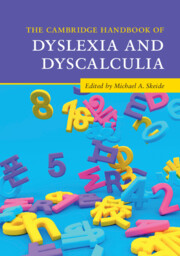Book contents
- The Cambridge Handbook of Dyslexia and Dyscalculia
- The Cambridge Handbook of Dyslexia and Dyscalculia
- Copyright page
- Contents
- Figures and Tables
- Contributors
- Acknowledgements
- General Introduction
- Part I Theoretical Frameworks and Computational Models
- Part II Cognitive Profiles and Behavioural Manifestations
- Part III Genetic and Environmental Influences
- Part IV Neurodevelopmental Foundations
- Part V Gender, Ethnicity, and Socioeconomic Background
- Part VI Cultural Unity and Diversity
- 15 Cross-Cultural Unity and Diversity of Dyslexia
- 16 Cross-Cultural Unity and Diversity of Dyscalculia
- Summary: Cultural Unity and Diversity
- Part VII Early Prediction
- Part VIII Intervention and Compensation
- Part IX Best Practice – Diagnostics and Prevention
- Part X Best Practice – Schooling and Educational Policy
- General Summary
- References
- Index
- References
15 - Cross-Cultural Unity and Diversity of Dyslexia
from Part VI - Cultural Unity and Diversity
Published online by Cambridge University Press: 28 July 2022
- The Cambridge Handbook of Dyslexia and Dyscalculia
- The Cambridge Handbook of Dyslexia and Dyscalculia
- Copyright page
- Contents
- Figures and Tables
- Contributors
- Acknowledgements
- General Introduction
- Part I Theoretical Frameworks and Computational Models
- Part II Cognitive Profiles and Behavioural Manifestations
- Part III Genetic and Environmental Influences
- Part IV Neurodevelopmental Foundations
- Part V Gender, Ethnicity, and Socioeconomic Background
- Part VI Cultural Unity and Diversity
- 15 Cross-Cultural Unity and Diversity of Dyslexia
- 16 Cross-Cultural Unity and Diversity of Dyscalculia
- Summary: Cultural Unity and Diversity
- Part VII Early Prediction
- Part VIII Intervention and Compensation
- Part IX Best Practice – Diagnostics and Prevention
- Part X Best Practice – Schooling and Educational Policy
- General Summary
- References
- Index
- References
Summary
In the simplest sense, reading acquisition is a process of learning how a writing system represents a spoken language. It requires conscious awareness of how the basic graphic symbol, the grapheme, represents a spoken unit. However, unlike language acquisition, which occurs naturally, rapidly, and automatically in most children, learning to read is a lifetime developmental process that requires effort, explicit instruction, and conscious awareness of the language structure (known as metalinguistic awareness). Many children fail to achieve full proficiency in reading, and some exhibit specific problems with reading, writing, and spelling despite adequate intelligence, motivation, and educational opportunity. This specific learning difficulty, known as developmental dyslexia, has varying incidence rates depending on the diagnostic criteria and the language examined. The divergent incidence rates, together with some findings suggesting that dyslexia has different behavioural and neural manifestations within and across cultures, has led to the question of whether the underlying causes of dyslexia differ across writing systems and whether it is possible to be dyslexic in one language and not dyslexic in another.
- Type
- Chapter
- Information
- The Cambridge Handbook of Dyslexia and Dyscalculia , pp. 267 - 281Publisher: Cambridge University PressPrint publication year: 2022
References
Suggestions for Further Reading
- 1
- Cited by

